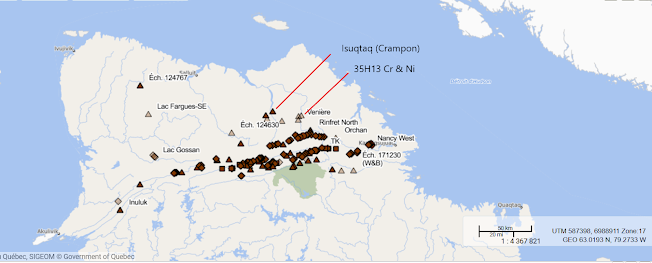(click on the map images to enlarge)
.png.jpg) | ||
| known nickel deposits area map |
.png)

Isuqtaq (Crampon) Ni + associated critical metals.
Isuqtaq (Crampon) discovery was made in 2018 by the MERN geologists mapping the Lac Watts formation area.
There is no prior Ni exploration history reported.
Isuqtaq (Crampon's) Lithology (Google translation from French) :
A peridotite diffuse metric zone is strongly altered in talc content in a serpentinized peridotite. The peridotite is interbedded with a dunite whose bedding is underlined by the alignment of the magnetite in pseudomorph of chromite. The ultramafic lithologies are located near a mylonitic metasediment.
Mineralization in altered peridotite consists of a very fine dissemination of sulphides
Analysis of selected samples:
- 2018073537 gave values of 2520 ppm Ni and 2270 ppm Cu,
- 2018073963 gave values of 3800 ppm Ni, 1350 ppm Cr and 52.8 ppb EGP, and
- 2018073534 gave 2000 ppm Ni and 1620 Cr and 705 ppb Au.
Typology: Magmatic Ni-Cu assoc., ultra-mafic intrusions. Magmatic Ni-Cu±PGE sulfide deposits can occur with a number of other magmatic ore deposits. These include low-sulfide, contact-type, and reef-type PGE deposits, chromite deposits, and Fe-Ti-V deposits.
Magmatic mineralization of Cr in ultramafic rocks and hydrothermal remobilization of nickel.
Principal chemical element: MgO
Secondary chemical elements: Ni, Cu & PGM
Fault defined ultramafic intrusion suggests potenital for large low grade disseminated Ni (awaruite) deposit of both magmatic and hydrothermal alteration with upside potential for komatiite type I using deep penetrating VTEM, as was discovered at Dumont Nickel. deposit.
All MERN Sampling data points 2018 map .
Nearly every grab sample taken has mineable Ni mineralization > 1000 ppm
with a constant amount of other critical metals.
For example Sc >30 ppm
Substantial MgO as a secondary open pit mineable resource.
(click on the map image to enlarge)
 |
| Bedrock and faults map |
Magmatic Cr mineralization in ultramafic intrusions with hydrothermal nickel and gold associated within a deformation zone.https://gq.mines.gouv.qc.ca/documents/PHOTOS/00610/0000007862_en.jpgIs located in deformed and strongly silicified wehrlite with an apparent thickness of 50 m. Analysis of two grab samples 650 m apart, 2018073685 revealed values of 15300 ppm Cr, 2480 ppm Ni, 66 ppb Au, 460 As and 116 ppm Co and grab sample 2018073682 revealed values of 8960 ppm Cr, 1900 ppm Ni and 144 ppm Co.https://gq.mines.gouv.qc.ca/documents/PHOTOS/00610/0000007876_en.jpghttps://gq.mines.gouv.qc.ca/documents/PHOTOS/00610/0000008518_en.jpg
VeniereGrab samples reveal 3% chromite mineralization and magnetite pseudomorph.Sample 2018073690 returned values of 7026 ppm Cr, 1760 ppm Ni and 110 ppm Co. A pyroxenite sample taken 300 m further south at outcrop 18-GM-5158 shows 2430 ppm Cr and 130 ppb EGP (2018073984). Nickel sampling data reveals wide-spread nickel
mineralization is both magmatic and hydrothermal alteration, increasing the potential for the
existence of a large low grade nickel deposit (NiS and NiFe) with associated metal credits. https://gq.mines.gouv.qc.ca/documents/PHOTOS/00610/0000007869_en.jpghttps://gq.mines.gouv.qc.ca/documents/PHOTOS/00610/0000007864_en.jpg
(click on the map image to enlarge)




%20%20Ni%20target.png)
%20%20%20chromite%20%20map.png)
%20%20%20cobalt%20greater%2030ppm%20%20map.png)
%20hi%20res%20Vertical%20gradient%20of%20residual%20magnetic%20map.png)

%20area%20%20sample%202018073963.jpg)






